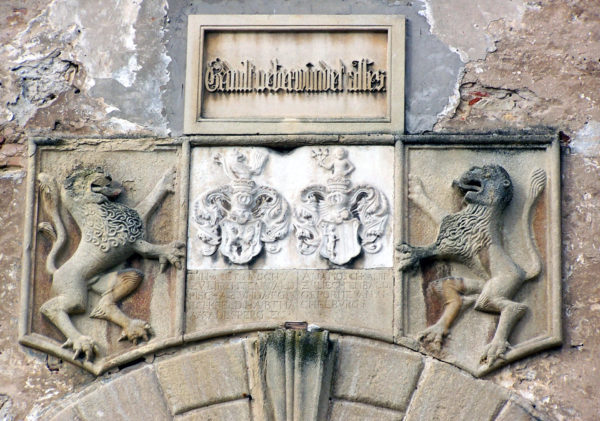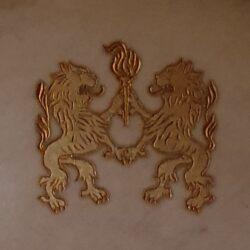
Arms of alliance of the Moscon and Aichelburg families in Sevnica Castle
SEVNICA, CASTLE
Location of the coat of arms: portal
As part of the estates that the bishops of Salzburg held in the Lower Sava Valley, Sevnica Castle remained their formal fief until 1803. Until the second half of the sixteenth century, it was administered by the castellans of Salzburg or held in lease by various noblemen. In 1595, the castle was bought by Innocent Moscon, which led to lasting disputes over its formal ownership. In 1637, the Moscons and the Archdiocese of Salzburg finally reached an agreement, under which the family obtained Sevnica in hereditary fief and Salzburg retained supreme authority over it for another 170 years. Immediately after purchasing the castle, Innocent Moscon thoroughly rebuilt it and turned it from a medieval fortification into a contemporary residence. After the restoration work was completed, he built in a plaque featuring a pair of lions holding his coat of arms and that of his wife Ana, née von Aichelburg, above the castle entrance. Below the coats of arms runs the following two-column inscription: INNOCENT. MVSCHKAN ZVM LIECHTENWALD PISCHAZ VND AVF GVRCHKFELD. HAVBTMAN AVF ADLSPERG ZC / ANA MOSCHKANIN ZVM LIECHTENBALD GEPORNE VAN AICHELBVRG. Emilijan Cevc describes the motif of the arms-bearing lions as “stereotypical and weak in design.” Nor can the year 1597, suggested by Ivan Stopar, be seen in the inscription or anywhere on the heraldic plaque. Cevc, too, dates the plaque roughly to “around 1597.” Above the heraldic plaque there is another plaque bearing the inscription Gedult ueberwundet alles (Patience conquers all).
Innocent Moscon was a member of a family that had barely begun its steep social climb in his lifetime. According to some studies, the Moscons originated in the small town of Lovere northeast of Bergamo and came to the Slovenian provinces as merchants in the early sixteenth century. The Carniolan Moscons embarked on their social climb as the heirs of Johann Baptist von Valvasor, who bequeathed most of his property to his nephews, the Moscons—Alexander, Innocent, Peter, Michael, and Mark Anton. The brothers also founded their respective family branches in Carniola and Styria, of which one was elevated to the rank of barons in 1617 and another to the rank of counts in 1709. The family as a whole became extinct in its male line in 1927.
As the inscription on the heraldic plaque indicates, Innocent (circa 1545–1623) was also the governor of Postojna. About 1570, he married Ana von Aichelburg, who, like him, did not descend from an old noble family. A burgher of Graz, her grandfather still carried the name Christoph Vierthaler at the end of the fifteenth century. However, in exchange for a large sum of money that he once lent to King Maximilian, the sovereign granted Christoph Aichelburg a castle in the Gail Valley in September 1500 and the noble title with the predicate Aichelburg in June 1507. The family abandoned the burgher name Vierthaler and called themselves only after Aichelburg. One of Christoph’s sons, Georg, was also the father of Ana, the future wife of Innocent Moscon.
Sources:
Adler, XII, 1938, pp. 435–441.
Cevc, Emilijan: Kiparstvo na Slovenskem med gotiko in barokom. Ljubljana: Slovenska matica, 1981, p. 171.
Kohla, Franz Xaver, Metnitz, Gustav Adolf, and Moro, Gotbert: Kärntner Burgenkunde. Ergebnisse und Hinweise in Übersicht (Part 2). Klagenfurt, 1973, pp. 3, 4.
Sapač, Igor: Stavbni razvoj gradu Sevnica. In: Grad Sevnica (ed. Oskar Zoran Zelič). Sevnica: Društvo Trg, 2011, pp. 15–54 (28–29).
Stopar, Ivan: Grajske stavbe v vzhodni Sloveniji. Med Kozjanskim in porečjem Save (vol. 5). Ljubljana: Viharnik, 1993, pp. 115–117.

